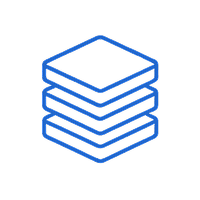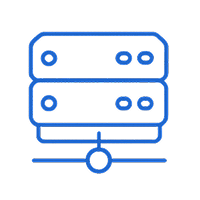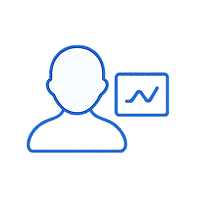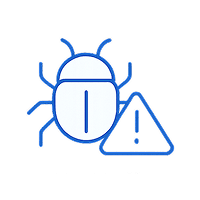Better Stack is a developer-first observability platform that offers log management, incident monitoring tools, visually appealing dashboards, and uptime monitoring. It offers integrations with cloud services, containerized environments, and third-party alerting tools, making it a good fit for fast-moving SaaS startups and mid-sized teams.
Despite its appealing UI and entry-level pricing, many teams find the transition from free to paid to be substantial and no self-hosting option, which limits their deployment options. CubeAPM is the best alternative to Better Stack that solves these challenges with a simple, predictable, and cost-efficient pricing of $0.15/GB and a self-hosting option to comply with data localization requirements.
In this article, we’ll break down the top 7 Better Stack alternatives and compare their key features, pros and cons, ideal use cases, and pricing.
Top 7 Better Stack Alternatives
- CubeAPM
- Datadog
- New Relic
- Dynatrace
- Coralogix
- SigNoz
- Sumologic
Comparison Table
| Tool | * Pricing (Small, Mid, Large Teams) | OTEL Native | Support TAT | Self-hosting |
| CubeAPM | Small: $2,080; Mid: $7,200; Large: $15,200 | Yes | Within minutes | Yes |
| Better Stack | Small: $5,723; Mid: $20,550; Large: $43,350 | Yes | < 4 hrs to 2 days | No |
| Datadog | Small: $8,185; Mid: $27,475; Large: $59,050 | Yes | <2-48 hrs | No |
| New Relic | Small: $7,896; Mid: $25,990; Large: $57,970 | Yes | 1 hr to 2 days | No |
| Dynatrace | Small: $7,740; Mid: $21,850; Large: $46,000 | Yes | 4 hrs to days | Yes |
| Coralogix | Small: $4,090; Mid: $13,200; Large: $29,000 | Yes | Min to hrs | No |
| SigNoz | Small: $4,600; Mid: $16,000; Large: $34,000 | Yes | Unavailable | Yes |
| Sumo Logic | Small: $4,641; Mid: $16,065; Large: $33,915 | Yes | <1 hr to 2 days | No |
*All pricing comparisons are calculated using standardized Small/Medium/Large team profiles defined in our internal benchmarking sheet, based on fixed log, metrics, trace, and retention assumptions. Actual pricing may vary by usage, region, and plan structure. Please confirm current pricing with each vendor.
Why Look for Better Stack Alternatives?
While Better Stack appeals to engineering teams with its clean interface, developer-first positioning, and affordable entry plans, it begins to fall short when organizations scale beyond basic monitoring needs. Users have repeatedly flagged key limitations on platforms such as G2. Common complaints include:
Pricing Complexity & Cost Spikes
While Better Stack offers a generous free tier (10 monitors, basic alerts/status page, limited log retention), growth, even modest, often triggers a jump to the $29/month paid plan per responder, with usage-based billing for metrics and data retention.
For small teams, side projects or open-source efforts, this can feel “steep” and unpredictable; as one G2 reviewer puts it. As usage grows with more monitors and more data, total spend can climb up substantially, prompting many to start exploring more cost-predictable or self-hosted alternatives.
No Self-Hosting
No self-hosted deployment available. Better Stack is offered exclusively as a managed SaaS; there is no publicly available on-prem or hybrid deployment option. While enterprise customers can configure log export to their own cloud accounts (e.g. S3), the core observability backend remains under Better Stack’s control.
Limited Advanced Features
Better Stack focuses on simplicity, fast setup, and ease of use, its documentation emphasizes a streamlined cloud-native workflow rather than deep enterprise customization.
However, G2 reviewers frequently mention “missing features,” limited configuration options, and a desire for more advanced integrations or customization as their systems grow more complex, indicating that the platform’s feature set can feel restrictive at scale.
Criteria for Suggesting Better Stack Alternatives
When evaluating Better Stack alternatives, we focused on platforms that go beyond basic log monitoring and address full-stack observability needs. Key criteria include:
End-to-End MELT Coverage (Metrics, Events, Logs, Traces)
Modern observability demands unified visibility across telemetry signals. Alternatives must offer full MELT support to ensure teams can correlate logs with traces, monitor infrastructure metrics, and track events, without jumping between siloed tools.
OpenTelemetry-Native Architecture
Tools should adopt OpenTelemetry as a first-class citizen, not just offer partial SDKs or wrappers. This ensures vendor neutrality, better data portability, and more precise instrumentation across services, libraries, and environments.
Smart Sampling and Cost-Efficient Ingestion
Volume-based billing without intelligent sampling leads to dropped signals or spiraling costs. The right alternative should support context-aware sampling—preserving high-value traces while reducing data volume—to achieve observability without financial overrun.
Transparent and Predictable Pricing
Pricing should be straightforward, without hidden fees, per-seat charges, or complex usage metrics (like DDUs or API quotas). Alternatives must allow teams to plan costs accurately as data scales, especially during production incidents or spikes.
Scalable Performance with Query Efficiency
As telemetry grows, the platform must maintain low-latency queries, fast dashboard rendering, and high ingestion throughput. Any bottlenecks in querying or storage can delay incident response and degrade developer experience.
Compliance-Ready Deployment Options
Some teams operate in regulated industries or restricted geographies. Alternatives should offer on-premise deployments or self-hosting to ensure compliance with data residency and security mandates and save costs.
Advanced Alerting & Automation
Multi-condition thresholds, anomaly detection, and intelligent routing/escalation workflows are useful features to look for. Built-in automation (e.g., suppression windows, alert correlation) is key for reducing alert fatigue and accelerating resolution.
Better Stack Overview

Known for
Better Stack is a developer-first platform that unifies uptime monitoring, log and trace management, infrastructure monitoring, incident management, and status pages into one cohesive observability toolkit. It’s especially popular among small to mid-sized engineering teams and SaaS startups for its fast setup and intuitive interface.
Overall, Better Stack is ideal for teams that prioritize usability, integrated incident response, and a rich free tier. While it covers many bases in modern telemetry, teams may eventually require more advanced alerting, self-hosting, or deeper customizations as they scale.
Standout Features
- eBPF-based OpenTelemetry tracing & infrastructure collection: Auto-instrument apps and infra with no code change.
- Integrated incident management with Slack workflows: Handle on-call scheduling, AI-powered post-mortems, smart merging, and escalation paths within Slack or via phone/SMS.
- Built-in uptime monitoring and status pages: Offers 30‑second checks, traceroute/MTR diagnostics, cron heartbeats, SSL/domain expiry detection, and branded status site functionality.
- Rich observability dashboards & SQL-like log queries: Leverages ClickHouse for fast index-backed querying across logs, metrics, and traces.
Key Features
- Unified Telemetry: Logs, traces, metrics, uptime—all visible in a single interface.
- Install-free tracing: eBPF-based OTEL collectors remove manual instrumentation.
- On-call & alerting: Unlimited phone calls, SMS, Slack/Teams integration, and AI incident noise suppression.
- Highly configurable uptime checks: Network diagnostics, Playwright-based synthetic tests, and heartbeat monitoring.
- 100+ integrations: Supports Datadog, New Relic, Grafana, Prometheus, AWS, Azure, GCP, Kubernetes, Zabbix, and more.
Pros
- Ease-of-use platform for beginners and experts
- The rich free plan includes 10 monitors, 1 status page, 3 GB logs, 2B metrics retained for 30 days, and Slack and email alerts.
- Developer-centered platform with simple setup and collaborative dashboards
- All-in-one decoupling eliminates the need for separate tools like PagerDuty, Statuspage.io, and Pingdom
- Supports ClickHouse for fast querying even on large datasets
Cons
- No self-hosting or on-premise option
- Significant jump in cost from free to paid
Best For
- Fast-moving SaaS startups and mid-sized tech teams that want end-to-end observability without managing multiple tools.
- Teams seeking rich free tier features—including uptime, logs, metrics, tracing, and incident response, without early commitment.
- Dev-centric workflows where Slack-based incident workflows and fast time-to-value matter.
Pricing & Customer Reviews
Pricing
- Free tier: Includes 10 monitors, 1 static page, 3 GB logs (3-day), 2B metrics points (30-day), 1 or more responders using Slack/phone/SMS.
- Paid plans: Start at $29/user/month, including one responder license and unlimited users, with bundles for telemetry and incident capabilities.
Customer reviews
- G2: 4.8/5 (292 reviews)
- Praised for: Ease of use, polished UX, free SMS/phone alerts, and uptime and status page support.
- Criticized for: Costly, no self-hosting
Top 7 Better Stack Alternatives
1. CubeAPM
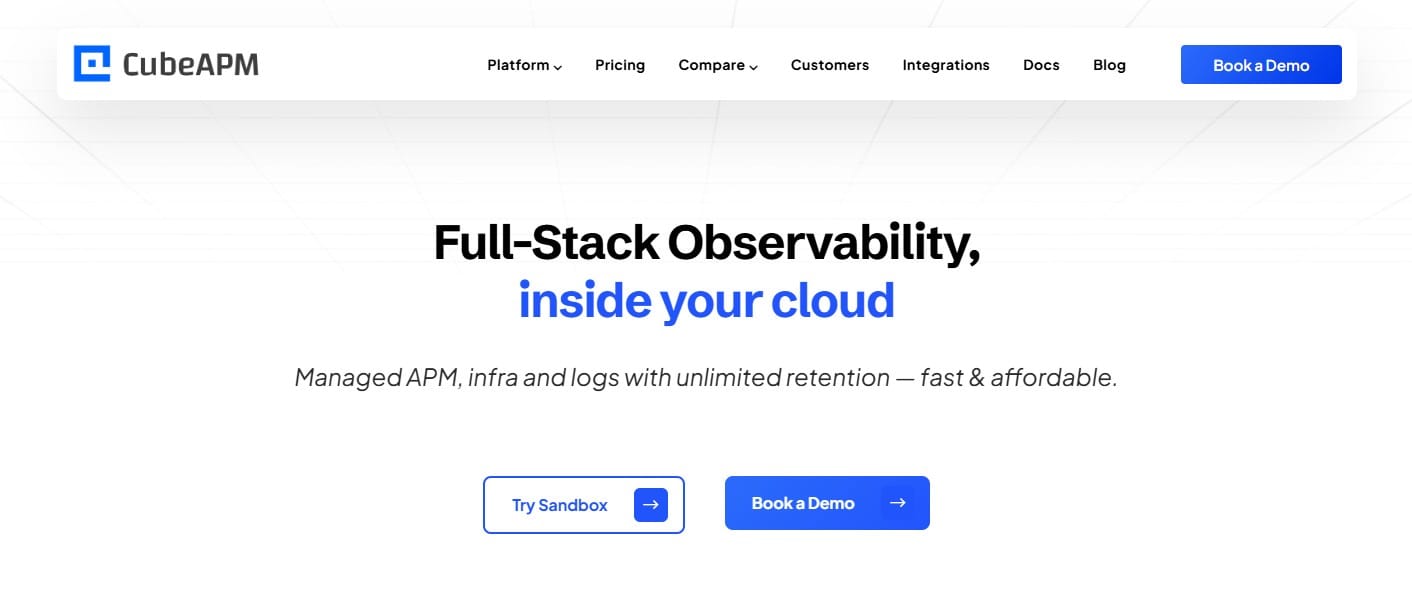
Known for
CubeAPM is a modern, OpenTelemetry-native observability platform designed for engineering teams that need complete MELT coverage (Metrics, Events, Logs, Traces), data sovereignty, and predictable pricing. Built with compliance and scale in mind, CubeAPM eliminates the blind spots and billing shocks common in volume-based SaaS platforms like Better Stack.
It supports on-prem deployments, making it ideal for organizations with data localization mandates. Unlike Better Stack, CubeAPM offers a full-stack observability solution—including synthetics, RUM, and smart sampling—at a fraction of the cost.
Standout Features
Smart Sampling Engine
CubeAPM intelligently samples high-value traces (e.g., those with errors, high latency, or anomalies), reducing data volume by up to 80% without losing critical insights. This allows engineering teams to preserve context for root-cause analysis—while keeping storage and processing costs low.
Flexible Hosting for Compliance
Teams can deploy CubeAPM on their own infrastructure or VPCs to retain 100% control over telemetry data—enabling compliance with GDPR, HIPAA, India’s DPDP Act, and more. Better Stack, by contrast, is SaaS-only and routes telemetry through its servers, limiting compliance options.
Instant Migration, Drop-In Compatibility
CubeAPM is fully compatible with Datadog, New Relic, AppDynamics, OpenTelemetry, and Prometheus. With out-of-the-box agent support, teams can migrate in under an hour—preserving existing pipelines, dashboards, and alerts without vendor lock-in.
Slack-Native Support from Engineers
CubeAPM offers direct Slack or WhatsApp support from core engineering teams, cutting down response times from hours or days (as with Better Stack) to minutes. For teams in incident mode, this is a critical advantage.
Key Features
- Unified MELT Observability: Native support for logs, traces, metrics, synthetics, and real user monitoring (RUM)—delivered in a single platform without integrations or add-ons.
- OpenTelemetry-First Architecture: Designed for full OTEL compatibility from day one—enabling vendor-neutral instrumentation, flexible pipelines, and precise sampling.
- Contextual Smart Sampling: Retains critical telemetry (errors, latency spikes) while discarding low-value traces—reducing ingest by 60–80% vs. raw sampling approaches.
- Transparent Pricing: No per-user or per-bundle charges. Pricing is $0.15/GB for data ingest, $0.01/GB for data transfer, and synthetics, infra, and error tracking are free—removing all the unpredictability of tiered billing models.
- Fast, No-Code Alerting: Alerts can be configured without YAML or complex DSLs. Thresholds, latency, and error rules route directly to Slack, webhooks, or on-call tools.
- Kubernetes-Native Monitoring: CubeAPM captures infrastructure metrics at the container, pod, and cluster level—integrated with logs and traces for seamless correlation.
- Optimized Dashboards: Real-time, prebuilt dashboards for databases, services, infra, and APIs—designed for instant visibility with minimal configuration.
- Enterprise-Grade Security: RBAC, SSO, MFA, and audit logs included—ensuring telemetry is secure, compliant, and well-governed.
Pros
- 60–80% cheaper than Datadog, New Relic, and Better Stack
- Drop-in migration for existing OpenTelemetry, Datadog, or Prometheus users
- Built-in support for RUM, synthetics, error tracking, and alerts
- On-premise and hybrid deployments for strict compliance use cases
- Real-time Slack support from engineers—not support tickets
- Clean, intuitive dashboards with minimal learning curve
Cons
- Not ideal if you’re looking for off-prem observability solutions
- A complete observability platform; no support for cloud security management
Best For
Engineering, DevOps, and platform teams at SaaS startups, mid-sized tech companies, and regulated enterprises looking for:
- Full MELT observability without vendor lock-in
- High sampling precision with low ingest volume
- Self-hosted environment
- Faster support
Pricing & Customer Reviews
Pricing
- Ingestion: $0.15/GB
- Infrastructure monitoring, synthetics, error tracking: Included
- Unlimited user model: No per-seat billing
- Smart sampling reduces ingest by up to 80%, further lowering total costs
- Custom pricing available for high-scale and enterprise users
Customer Sentiment
- G2 Rating: 4.7/5
- Praised for: Transparent pricing, fast support, smart sampling, low-latency dashboards
CubeAPM vs Better Stack
Better Stack excels in simplicity and all-in-one incident management, but it lacks on-prem deployment options and can be costly for small teams.
CubeAPM, by contrast, is cost-efficient and offers self-hosting support. It gives teams fine-grained telemetry control with smart sampling and 60–80% cost savings. Whether it’s real-time debugging, production incident response, or compliance-driven telemetry, CubeAPM is a smarter, more flexible alternative, engineered for scale.
2. Datadog
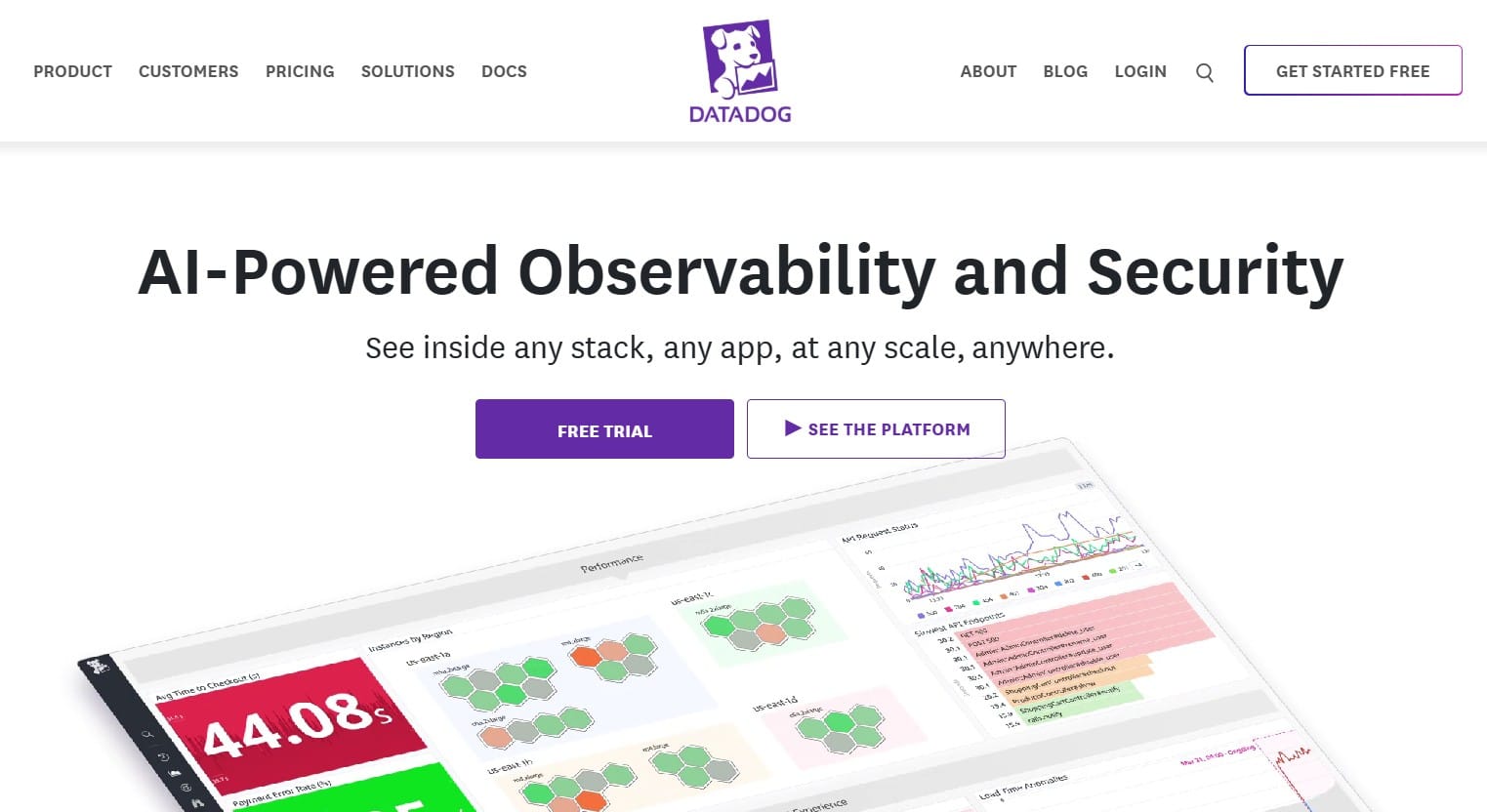
Known for
A cloud-native, all-in-one observability and security platform, Datadog is widely adopted by modern engineering and DevOps teams for its powerful integrations, real-time monitoring, and seamless support across infrastructure, logs, APM, and security—all via SaaS.
Standout Features
Extensive Integrations
Supports 900+ technologies, including AWS, Azure, GCP, Kubernetes, Docker, Jenkins, PostgreSQL, Redis, and Kafka—making it simple to unify telemetry from diverse sources without custom exporters.
Notebooks & Live Dashboards
Interactive dashboards with drag-and-drop widgets and Notebooks that blend metrics, logs, and traces into collaborative incident investigations.
Integrated Security Monitoring
Combines observability and DevSecOps—including CSPM, runtime threat detection, audit logs, and SIEM-style alerting.
Key Features
- Full-stack Observability: Unified MELT coverage (Metrics, Events, Logs, Traces) + RUM, synthetics, and CI/CD visibility.
- Distributed Tracing: Code-level visibility with trace explorer, service maps, and span-level drilldowns supporting major languages.
- Infrastructure Monitoring: Collects CPU, memory, disk, network, container, and Kubernetes metrics, visualized via interactive topology maps.
- Log Management: “Logging without Limits™” architecture supports ingesting all logs with tiered querying, pipelines, forwarding, and anomaly detection.
- RUM & Synthetics: Tracks user sessions, offers session replay, browser/API monitoring.
- AI-Powered Insight: Watchdog uses ML to detect anomalies and surface root causes without manual rule setup.
- Security Modules: Includes cloud workload security, CSPM, cloud SIEM, and audit trails.
Pros
- Massive integration ecosystem with top-tier extensibility
- Unified platform combining observability, security, and CI/CD insights
- Interactive dashboards, collaborative Notebooks, and real-time monitoring
- Ideal for complex, multi-cloud, Kubernetes-based development environments
- Strong enterprise and security tooling
Cons
- Complex pricing based on per-host, per-GB, per-session, per-custom-metric, plus separate charges for logs, RUM, synthetics, and security.
- Cloud-only deployment, no self-hosted option
Best for
Mid-to-large enterprise DevOps teams, cloud-native organizations, and security-conscious companies seeking a single pane of glass for observability and security—provided they can manage a complex pricing model and SaaS dependency.
Pricing & Customer Reviews
Pricing (based on annual billing)
- Infrastructure Monitoring: Free tier, paid – $15-$34/host/month
- APM (Application Performance Monitoring): $31–$40/host/month (billed yearly), $36/month on-demand
- Log Indexing/Retention: $0.1/GB + $1.7/M events (15d)
- Serverless: $10 per million function invocations
- Security Monitoring: $15–$40/user/month
- Real User Monitoring (RUM): Starts $3 per 1,000 browser sessions
- Synthetic Monitoring: Starts $5 per 10,000 API tests
Customer Sentiment
- G2 Rating: 4.4/5 (600+ reviews)
- Positive: Integrations, feature breadth, visualization quality
- Negative: Cost unpredictability, complexity, high ingestion fees
Datadog vs Better Stack
Datadog offers significantly broader observability capabilities compared to Better Stack. It provides deep APM, distributed tracing, synthetic monitoring, RUM, and a comprehensive security suite, backed by over 900+ integrations. It’s ideal for large-scale, multi-cloud environments.
In contrast, Better Stack focuses primarily on logs, uptime, and incident management. While easier to set up, it lacks advanced telemetry correlation, AI-driven alerts, and infrastructure-wide tracing. Datadog, though powerful, comes with complex usage-based pricing that can be difficult to forecast at scale, whereas Better Stack maintains more predictable costs for smaller teams.
3. New Relic
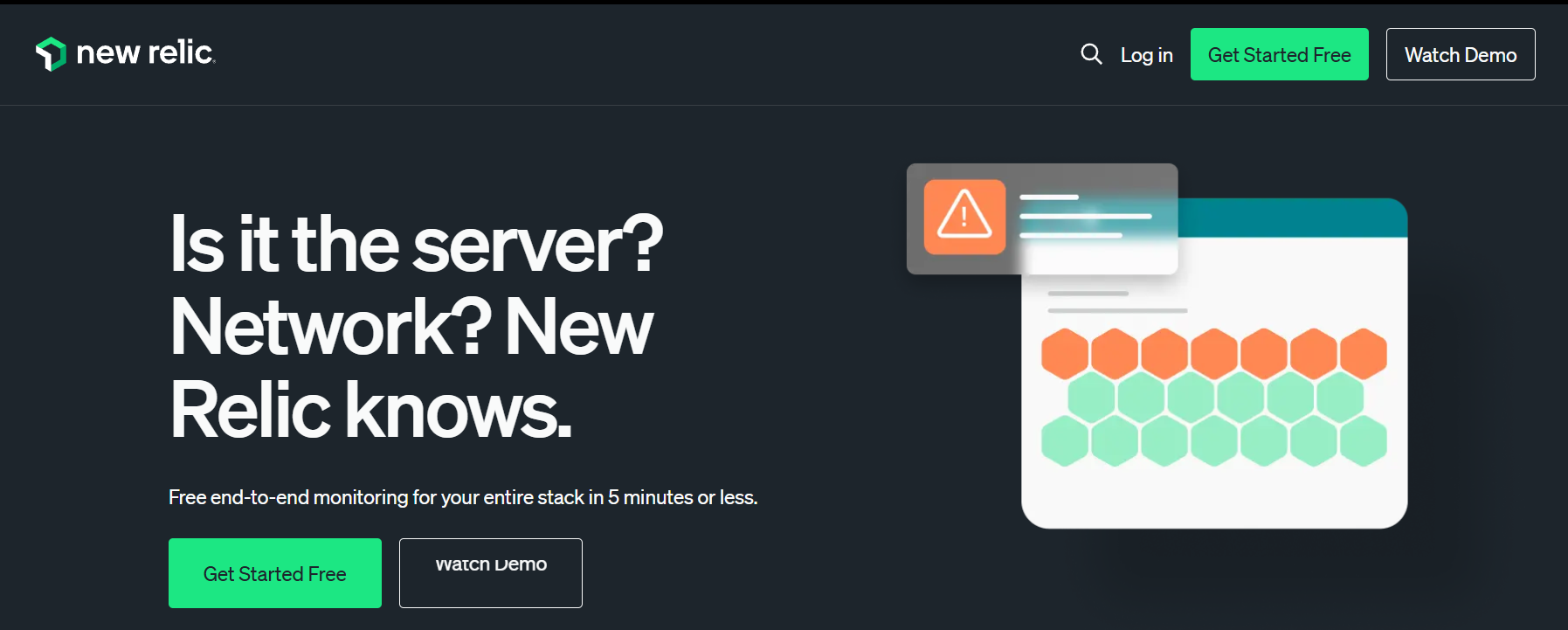
Known for
A flexible, developer-friendly observability platform offering full-stack monitoring, custom dashboards, and rich telemetry exploration using its proprietary NRQL query language. New Relic is widely adopted for real-time analytics, APM, infrastructure visibility, and frontend monitoring—all within a unified SaaS interface.
Standout Features
New Relic Query Language (NRQL)
A powerful, SQL-like query engine that lets teams correlate metrics, logs, events, and traces in real time—fueling advanced dashboards, anomaly detection, and ad-hoc investigations without external tools.
Explorer View
A topology-aware UI that visualizes dependencies among apps, services, containers, databases, and hosts—ideal for debugging distributed systems and Kubernetes stacks.
Lookout Anomaly Detection
ML-driven anomaly detection that automatically surfaces regressions and unusual behavior across telemetry signals, reducing manual alert tuning.
Customizable Dashboards
Prebuilt widgets and custom visualizations support rich views of system health, MTTR, SLO tracking, and service performance.
Key Features
- Full-MELT Observability: Unified coverage across Metrics, Events, Logs, Traces, and Real User Monitoring (RUM), with additional support for browser session replay, frontend latency tracking, and synthetic checks.
- Polyglot Instrumentation: Supports Java, Python, .NET, Node.js, Go, Ruby, PHP, and more, enabling full distributed tracing, profiling, and diagnostics.
- Partial OTEL & Prometheus Support: Offers OpenTelemetry compatibility, though many scenarios require dual agents; includes Prometheus metric ingestion with separate configuration.
- Alerting & Anomaly Thresholds: Supports NRQL-based and static threshold alerts, multi-condition policies, and Lookout-driven anomaly detection.
- Cloud-Native Integrations: Natively monitors AWS, GCP, Azure, Kubernetes, Lambda, and containerized architectures—supporting hybrid and multi-cloud environments.
Pros
- NRQL enables fine-grained telemetry querying and correlation.
- Visual feedback via Explorer topologies and live dashboards.
- ML-powered Lookout reduces alert noise and surfaces issues faster.
- Comprehensive APM and observability controls.
- Ideal for graph- and query-driven users who want hands-on analytics.
Cons
- Complex, usage-based pricing with ingestion and user charges.
- SaaS-only deployment, no on-prem or private cloud option.
- Steep learning curve for NRQL
Best For
Engineering and DevOps teams that need fine-grained observability, advanced querying (via NRQL), and don’t mind managing a query-centric workflow in a SaaS environment.
Pricing & Customer Reviews
Pricing
- Free tier: Includes 100 GB/month ingest, 1 full-platform user, and unlimited basic/core users.
- Additional ingest: $0.35–$0.55/GB depending on retention
- Core users: $0 to $49/user/month; includes logs, IDE integration, and error tracking.
- Full platform users:
- $10/first user; $99/additional (Standard edition)
- $349/user (Pro) for yearly billing; $418.80/user (for monthly pay-as-you-go)
Customer Sentiment
- G2 Rating: 4.4/5 (500+ reviews)
- Praised for: NRQL power, custom dashboards, performance monitoring
- Criticized for: Pricing complexity, SaaS-only structure, agent/tool overlap
New Relic vs Better Stack
New Relic delivers a more developer-centric and customizable observability experience through NRQL and Explorer View. It supports full MELT visibility, advanced alerting policies, and partial OpenTelemetry support—making it suitable for teams requiring real-time telemetry analytics and flexible dashboarding.
Better Stack, while strong in log ingestion and status monitoring, lacks the query-driven exploration, anomaly detection, and depth of instrumentation found in New Relic. However, Better Stack’s UI and bundled pricing appeal to teams that prioritize simplicity over custom analytics. New Relic may involve a steeper learning curve and more granular billing, but offers richer observability overall.
4. Dynatrace
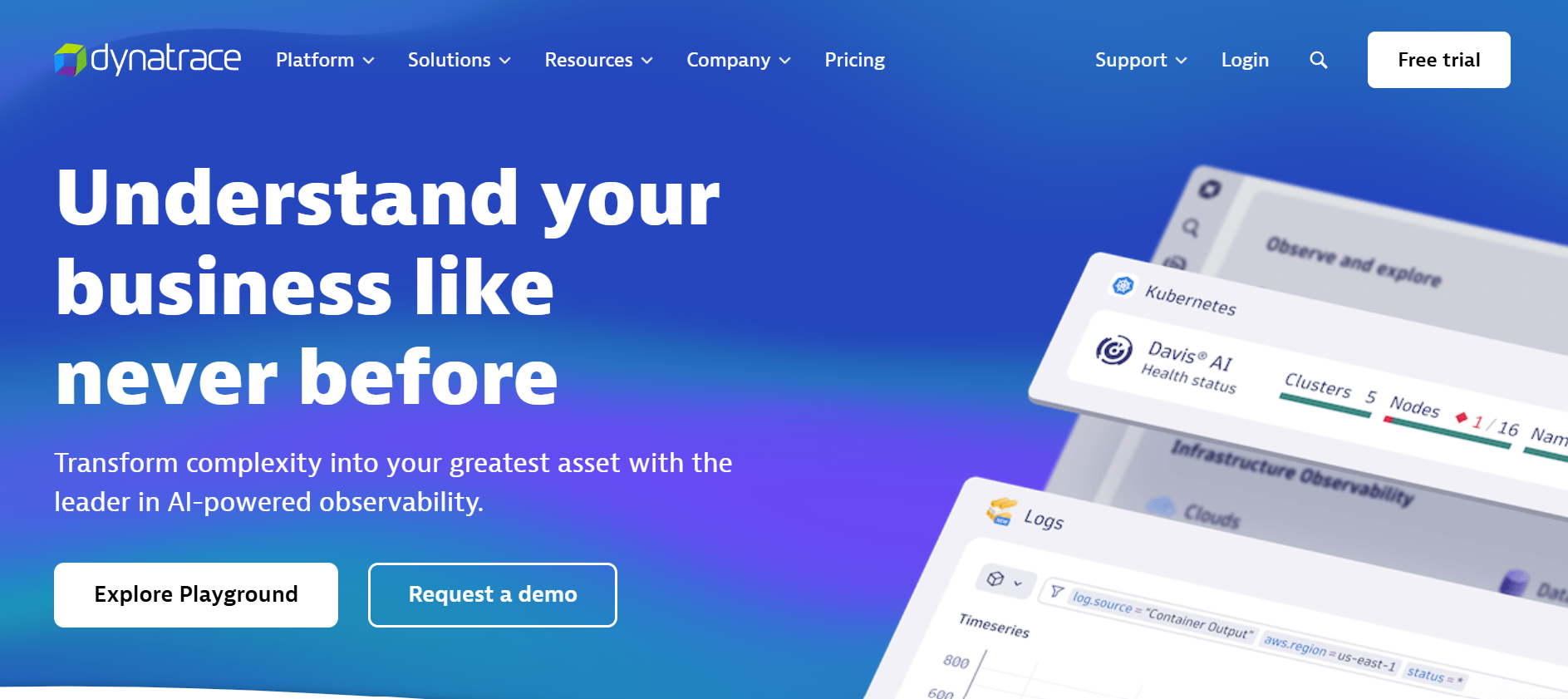
Known for
Dynatrace is a premium full-stack observability platform with built-in AI, automated dependency mapping, and integrated application security. It’s widely used by enterprise teams operating across cloud, on-prem, and hybrid environments that demand real-time root cause analysis and robust infrastructure intelligence.
Standout Features
Davis AI for Root Cause Automation
Davis AI continuously correlates telemetry from infrastructure, applications, and services to automatically pinpoint root causes—eliminating manual triage during incidents. It uses topology context from SmartScape to inform automated decisions.
SmartScape Topology Mapping
Automatically creates real-time dependency graphs, visualizing relationships among infrastructure, services, containers, and processes. Useful for debugging complex microservice architectures.
Runtime Application Protection (RASP)
Monitors live applications for vulnerabilities and malicious behavior, integrating observability with application-layer security for DevSecOps workflows.
Digital Experience Monitoring (DEM)
Combines RUM and synthetic tests to track user experience end-to-end and correlate frontend performance with backend health.
Key Features
- Full MELT coverage: logs, metrics, events, traces, infrastructure, RUM, and synthetic checks (DEM).
- Auto-instrumentation: OneAgent auto-discovers apps, containers, VMs, and serverless across languages like Java, .NET, PHP, Node.js, and Python.
- Code-level insights: drill down into transaction traces to method-level granularity.
- AI-powered alert correlation: Davis groups related incidents, reducing alert fatigue and prioritizing real root causes.
- Cloud-native integration: deep AWS, Azure, GCP, and Kubernetes observability.
- Log analytics: ingested logs are indexed and correlated contextually.
Pros
- All-in-one observability + application security platform.
- Davis AI delivers fast, accurate root cause identification.
- SmartScape offers real-time system dependency visualization
- Auto-instrumentation reduces setup effort.
- Awards comprehensive monitoring for cloud-native environments.
Cons
- Complex DDU-based pricing can be hard to forecast
- Can overwhelm smaller teams due to platform depth or plenty of features
Best For
Large enterprises and platform teams that manage complex, high-scale cloud or hybrid systems that require real-time AI-driven root cause analysis, topology visibility, and built-in security—all within one tightly integrated environment.
Pricing & Customer Reviews
Pricing (hourly / usage-based)
- Full-Stack Monitoring: $0.08 per 8 GiB host
- Infrastructure Monitoring: $0.04/hour per host.
- Container (K8s) Monitoring: $0.002/hour per pod.
- Application Security (RASP): $0.018/hour per 8 GiB host.
- Real User Monitoring (RUM): $0.00225 per session.
- Synthetic Monitoring: $0.001 per HTTP check or plugin test.
Customer Sentiment
- G2 Rating: 4.5/5 (1,300+ reviews)
- Praised for: AI insights, automation, enterprise-grade security
- Criticized for: Complex pricing, limited OTEL support, and lack of full on-prem options
Dynatrace vs Better Stack
Dynatrace is engineered for enterprise-grade observability with automation at its core. It’s Davis AI pinpoints root causes automatically, and SmartScape topology maps dependencies in real time. This makes Dynatrace a go-to for large, distributed environments where self-healing, root cause detection, and runtime security are critical.
Better Stack’s approach is more lightweight and focused on developers. It lacks real-time topology awareness, AI-driven automation, and runtime vulnerability protection. While Better Stack is easier to adopt, Dynatrace delivers a far more comprehensive and intelligent observability experience for complex environments, albeit at a premium price and steeper setup curve.
5. Coralogix
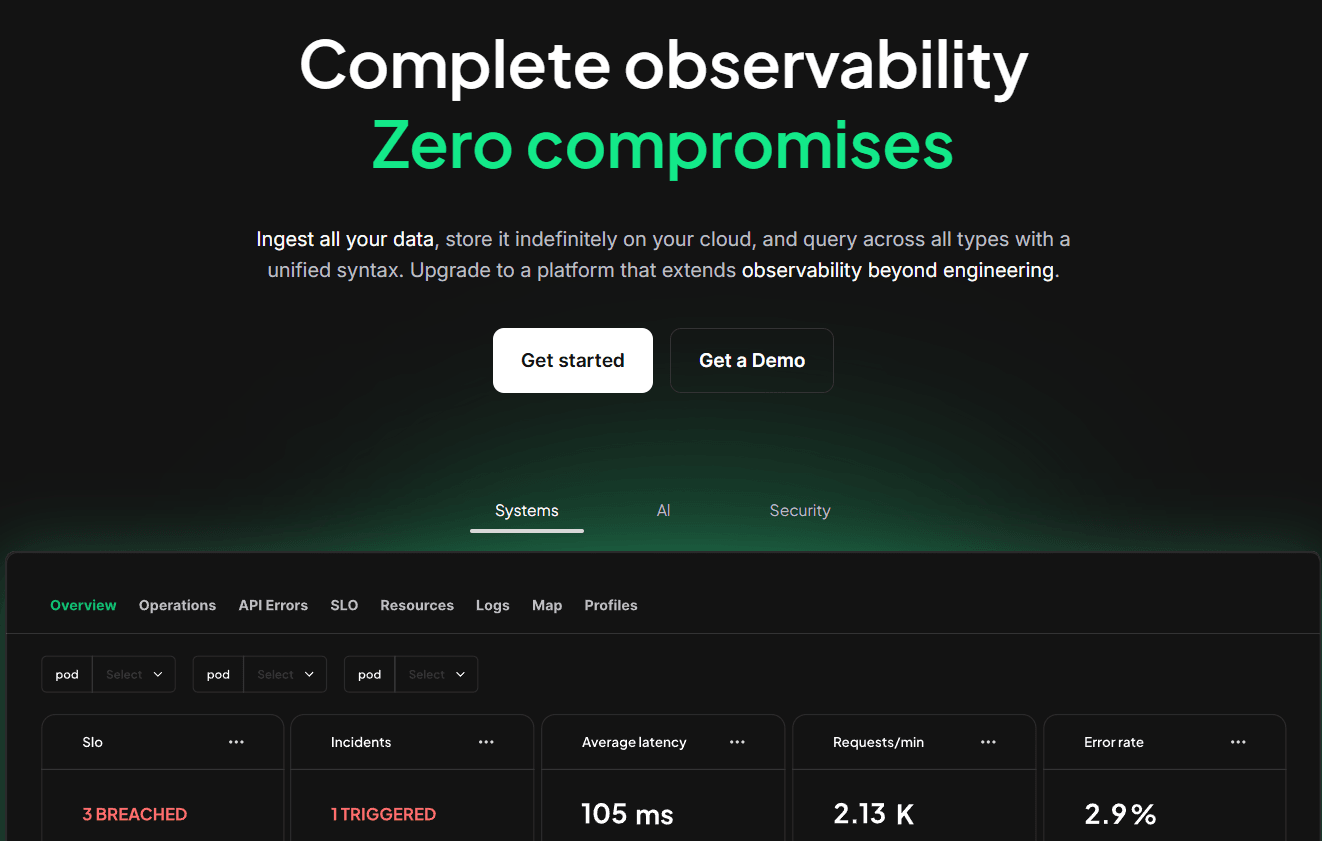
Known for
Coralogix is a full-stack observability platform built for teams ingesting large telemetry volumes. It focuses on cost-efficient log routing, real-time processing, and flexible long-term archival—empowering DevOps and security teams with granular data control and pipeline observability.
Standout Features
Native OpenTelemetry & Indexless Querying
Coralogix supports full OpenTelemetry ingestion. Logs can be routed via rules to indexing, low-cost archives, or real-time stream processing—enabling cost control at a per-log level.
Streama™ Real-Time Processing
Streama processes logs and metrics during ingestion—triggering alerts and analytics before indexing finishes—resulting in near-instant anomaly and alert detection.
Customer-Managed Archival
Logs, traces, and metrics can be archived to customer-managed S3 or GCS buckets, with free archival charges from Coralogix. Note: egress costs still apply, and initial data traverses Coralogix infrastructure, which may affect compliance.
GitOps-Driven Configuration
Dashboards, alerts, pipelines, and rules can be described in Git—making observability infrastructure versioned and auditable.
Key Features
- Log-Centric Observability: Core functionality revolves around logs, with complementary support for metrics and traces.
- Smart Log Routing: Users can assign logs to different “pipelines” (e.g., Frequent Search, Monitoring, Archive) based on value—balancing cost and visibility
- ML-Based Anomaly Detection: Automatically surfaces spike patterns and deviations in log data.
- Ingest-Time Alerting: Coralogix can trigger Flow Alerts directly at ingest, before data indexing, enabling millisecond-fast detection.
- Cloud-based deployments: Offers hosted SaaS and VPC-hosted options, though self-managed setups require customer governance.
- SIEM compatibility: Enables export to external analytics platforms (Snowflake, SIEM tools) via archive querying.
Pros
- Excellent cost control and visibility across high-volume log pipelines
- Real-time alerts and insights without indexing delay
- Allows archiving in your own cloud at no extra tier costs
- GitOps pipeline management supports compliance and agility.
Cons
- Mostly SaaS, so organizations with complete on-prem/self-hosting needs can reevaluate the platform
- Learning curve
Best For
Organizations operating large-scale log pipelines that need fine-grained control over log routing, real-time alerting, and archival cost management—especially when logs form the backbone of their observability or security workflows.
Pricing & Customer Reviews
Pricing
- Log Ingestion Costs: $0.42/GB, depending on pipeline and query volume
- Metric Ingestion: $0.05/GB
- Trace Ingestion: $0.16/GB
Customer Sentiment
- G2 Rating: 4.6/5 across 300+ reviews
- Praised for: Log pipeline flexibility, real-time alerting, and cost savings through fine query control.
- Criticism: Surprise egress costs, limited metric/tracing depth, and data localization concerns in regulated environments.
Coralogix vs Better Stack
Coralogix and Better Stack take very different approaches. Better Stack is simple—geared towards fast log ingestion, incident management, and uptime checks. Coralogix, on the other hand, is log-centric but offers fine-grained routing and real-time Streama™ processing that allows ingest-time alerting and flexible archival in the customer’s cloud.
Where Better Stack indexes all logs into a uniform workflow, Coralogix lets users route data to different tiers (indexed, unindexed, or archived), reducing storage costs. However, Coralogix still processes data through its infrastructure, which raises data localization and egress cost concerns. Better Stack lacks such flexibility, but also avoids that complexity. For teams needing log pipeline customization, Coralogix provides more control—while Better Stack favors simplicity and speed.
6. SigNoz
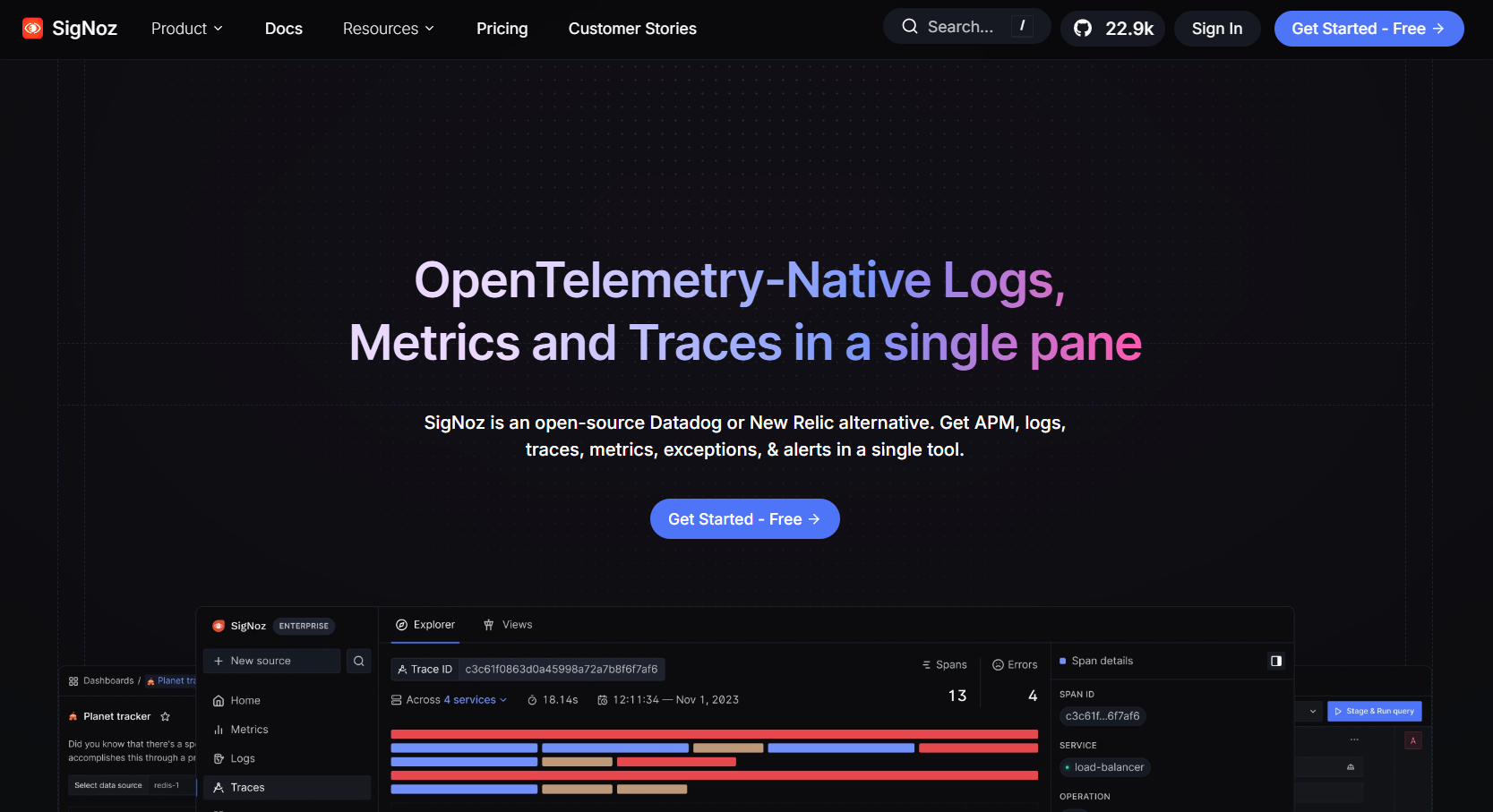
Known for
SigNoz is an open-source, full-stack observability platform built on ClickHouse and Apache Kafka. It offers unified logging, tracing, and metrics in a single coherent interface—without the vendor lock-in and cost constraints of proprietary SaaS tools. Developers embracing full control and cost visibility commonly choose SigNoz.
Standout Features
ClickHouse-Powered Analytics
Enables lightning-fast querying for logs, metrics, and traces—even at scale.
Full OTEL Native
100% natively supports OpenTelemetry ingestion for metrics, logs, and traces—ensuring seamless integration and vendor portability.
Self-Hosting & On-Prem Options
SigNoz can be self-hosted via Helm Charts or Docker Compose, granting teams full data sovereignty and architectural flexibility.
Error & Alerting Support
Alerts based on latency, error rates, and anomaly detection, tied directly into dashboards.
Key Features
- Unified UI for Logs & Traces: Correlate traces with logs interactively, helping debug cross-service failures.
- Host & Kubernetes Infrastructure Monitoring: Provides real-time metrics on CPU, memory, network, pods, containers, and nodes.
- Service Maps & Trace Analytics: Offers visualizations of service dependencies to streamline root-cause tracking.
- Prometheus-Compatible: Accepts Prometheus metrics alongside OTEL data—ideal for teams shifting from Prometheus.
- Alerting with Webhooks: Integrates with Slack, PagerDuty, email, and custom alerting endpoints for real-time notifications.
Pros
- No vendor lock-in—self-hostable and observability stack under your control.
- Full MELT observability—metrics, events, logs, traces, with linkages.
- Cost-effective—ClickHouse powers large workloads affordably.
- Rapid onboarding—community support and intuitive UI.
- Transparent observability pipeline—built on open standards.
Cons
- Pre-built integrations and dashboards are only available in paid plans
- Most support features are in paid plans
Best For
Engineering, DevOps, or SRE teams in startups and mid-sized orgs seeking a scalable, open-source, OTEL-native stack with full self-hosted control and no hidden costs.
Pricing & Customer Reviews
Pricing
- Free tier; charges beyond the base fee are based on data ingested
- Paid: Starts $49/month
- Traces: $0.30/GB.
- Logs: $0.30/GB.
- Metrics: $0.10/million samples.
Customer Sentiment
- G2 Rating: 4.6/5
- Praised for: OpenTelemetry support, UI clarity, and cost-effectiveness.
- Common Criticism: Lack of features like synthetic monitoring and commercial support.
SigNoz vs Better Stack
SigNoz is built for OpenTelemetry-native, self-hosted observability. It provides unified metrics, traces, and logs, and uses ClickHouse for cost-efficient storage. Unlike Better Stack, SigNoz offers full MELT coverage and the ability to host your stack on-premise or in your VPC—ideal for teams prioritizing data control and cost transparency.
Better Stack, by contrast, is SaaS-only and prioritizes ease of use over depth. It does not offer native support for infrastructure metrics or advanced tracing. While Better Stack is easier to deploy, SigNoz caters to teams that value ownership, flexibility, and open standards. However, SigNoz may require more operational overhead and lacks incident response features baked into the UI.
7. Sumo Logic
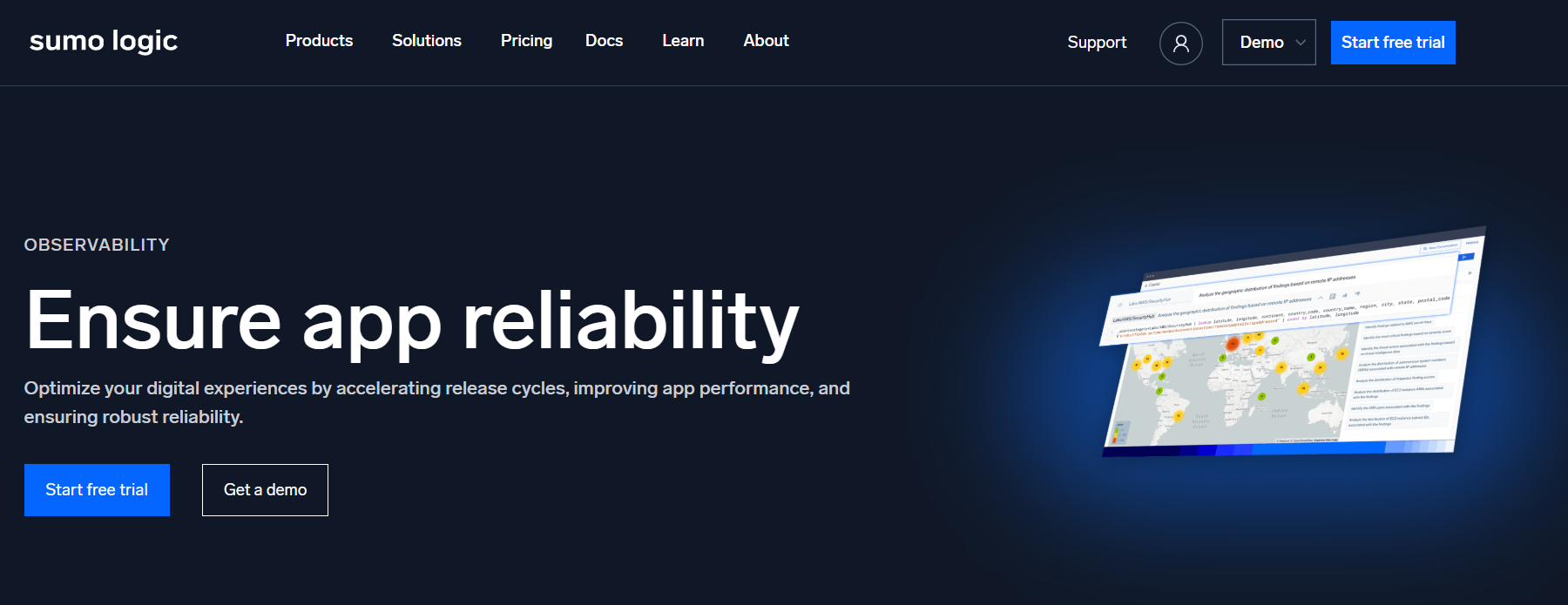
Known for
Sumo Logic is a cloud-native SIEM and log analytics platform focused on security, compliance, and advanced log monitoring. It integrates logs, metrics, and traces to provide real-time threat detection and operational intelligence at scale—making it especially popular with security-conscious enterprises.
Standout Features
Cloud SIEM & Threat Detection
Combines log analytics with security event monitoring, anomaly detection, and threat hunting workflows.
Machine Learning Analytics
Offers anomaly detection, predictive forecasting, and smart baselines to spot issues and risks across telemetry signals.
Pre-Built Compliance Content
Includes templates and alerts for PCI DSS, HIPAA, GDPR, and other regulated use cases.
Key Features
- Log, Metric & Trace Analytics: Aggregates telemetry data with integrations across AWS, Azure, GCP, Kubernetes, Docker, and major frameworks.
- Streaming Analytics Engine: Processes logs and metrics in real time to generate alerts before data is fully stored.
- Interactive Dashboards & Search: Offers real‑time exploration with analytics tools like LogReduce and LogCompare.
- SIEM & Security Modules: Security analytics, user activity tracking, threat intelligence feeds, and compliance alerting.
- Cloud Platform Monitoring: Provides visibility into container usage, serverless workloads, and infrastructure health.
Pros
- Excellent for log security analysis and compliance-heavy environments
- Real-time ML-enabled detection and alerting.
- SaaS-based scaling with minimal deployment complexity.
- Rich catalog of compliance-focused dashboards and tooling.
- Support via portal, email, and phone
Cons
- Costly, especially at large ingestion volumes or advanced feature tiers
- Learning curve is steep
- UI performance issues
Best For
Security-centric, compliance-heavy enterprises need powerful log analytics, real-time threat detection, and integrated SIEM capabilities.
Pricing & Customer Reviews
Pricing
- Free tier
- Paid: Pricing is based on data ingest and features enabled.
- Logs: $3.14 per TB scanned
- Metrics: available via add-ons
- Traces: supported but priced as part of advanced observability plans
Customer Sentiment
- G2: 4.3/5
- Praised for: Security analytics, dashboards, compliance support
- Criticized for: Cost, learning curve
Sumo Logic vs Better Stack
Sumo Logic is a log and security analytics platform that incorporates SIEM, anomaly detection, and compliance tooling. It’s built for high-volume ingestion and enterprise-grade security monitoring, with modules for threat detection, audit trails, and regulatory reporting. Better Stack is developer-friendly, but lacks SIEM capabilities, threat intelligence integration, and security-focused analytics.
Conclusion: Choosing the Right Better Stack Alternative
As observability needs evolve beyond clean dashboards and basic log monitoring, engineering teams are seeking platforms that offer deeper visibility, better cost control, and enterprise-ready flexibility. While Better Stack shines with its user-friendly design and all-in-one alerting, it’s a SaaS-based platform with no self-hosting option, and the transition from its generous free tier to paid is slightly abrupt.
CubeAPM is a good Better Stack alternative with complete self-hosting deployment and cost-effectiveness, with just $0.15/GB of data ingested. The pricing doesn’t include any extra charges for data retention or egress. The platform is OpenTelemetry-native and is feature-rich for full-stack observability. Get started with CubeAPM today!
Disclaimer: The information in this article reflects the latest details available at the time of publication and may change as technologies and products evolve.
FAQs
1. What’s the best alternative to Better Stack for full-stack observability?
CubeAPM is one of the best Better Stack alternatives, offering full MELT (Metrics, Events, Logs, Traces) coverage. While Better Stack focuses on logs and uptime, CubeAPM provides deeper insights across infrastructure, tracing, RUM, and synthetic monitoring—ideal for growing engineering teams.
2. Why do teams move away from Better Stack?
Teams often outgrow Better Stack due to:
– Pricing tied to usage tiers and responder licenses
– No self-hosting deployments
3. Is CubeAPM a good Better Stack alternative?
Yes. CubeAPM is one of the best alternatives to Better Stack, offering:
– Full MELT observability (APM, logs, infra, synthetics, RUM)
– Smart sampling for lower ingest volumes and cost
– OpenTelemetry-native ingestion
– On-prem or self-hosting deployment to meet compliance needs
– Transparent, simple pricing
CubeAPM is especially suited for startups, scale-ups, and regulated enterprises needing performance and cost predictability.
4. What’s the most cost-effective Better Stack alternative?
CubeAPM is widely regarded as the most cost-effective alternative to Better Stack. It’s priced at just $0.15/GB of data ingested that covers all logs, infra, APM, synthetic tests, and RUM, without extra egress or data retention charges. It also uses context-aware sampling to reduce data volumes.
5. Are there any alternatives that support OpenTelemetry natively?
Yes, some modern observability platforms, such as CubeAPM, are built around OpenTelemetry as a first-class standard. These platforms offer native ingestion for OTEL logs, traces, and metrics—eliminating the need for proprietary agents or dual setups. This ensures seamless integration with your existing pipelines while improving cost-efficiency, sampling precision, and long-term flexibility.


